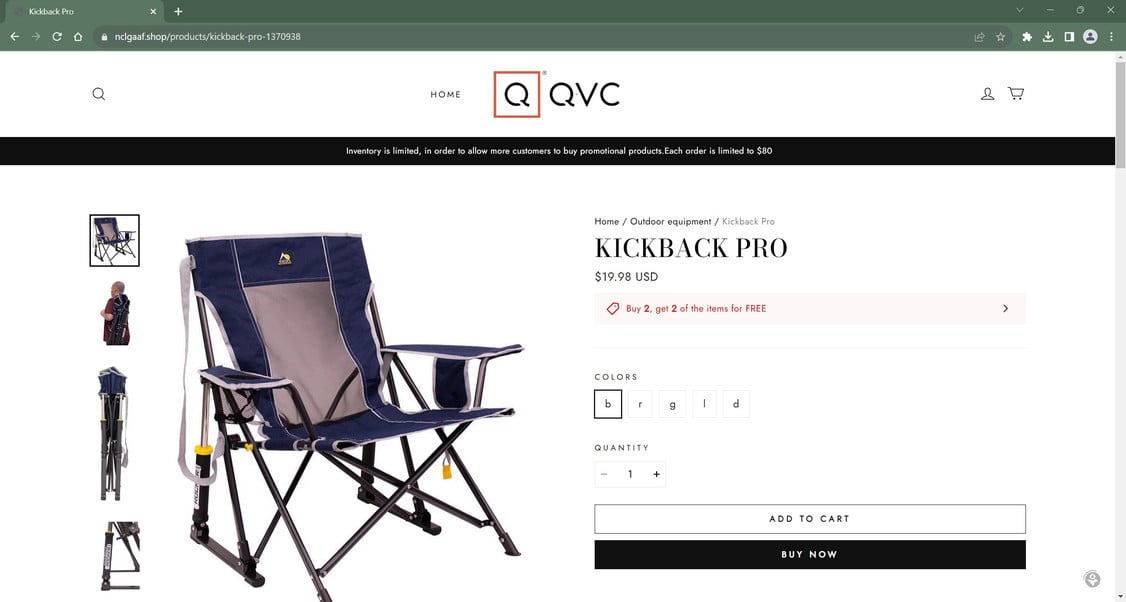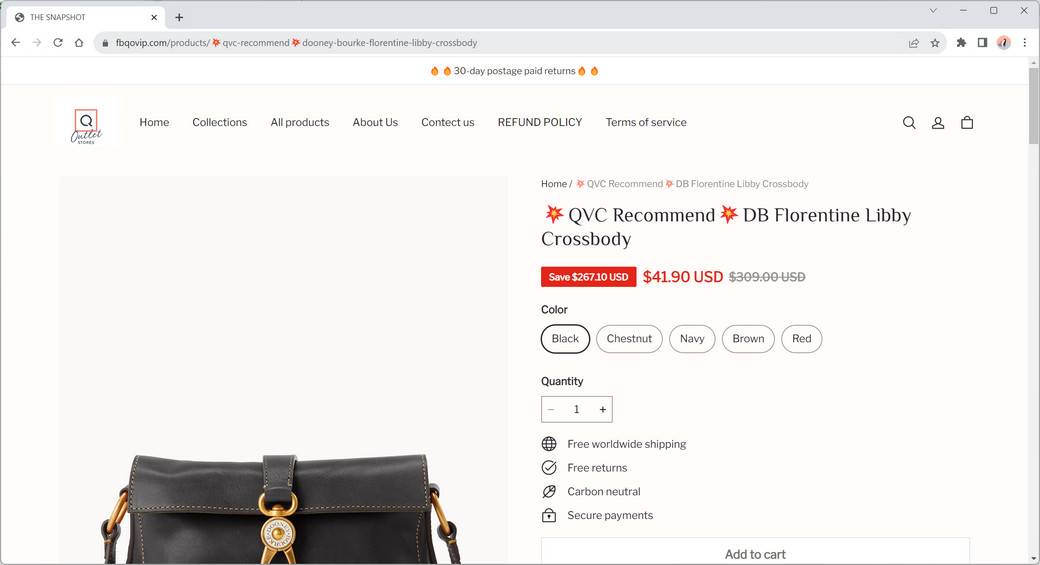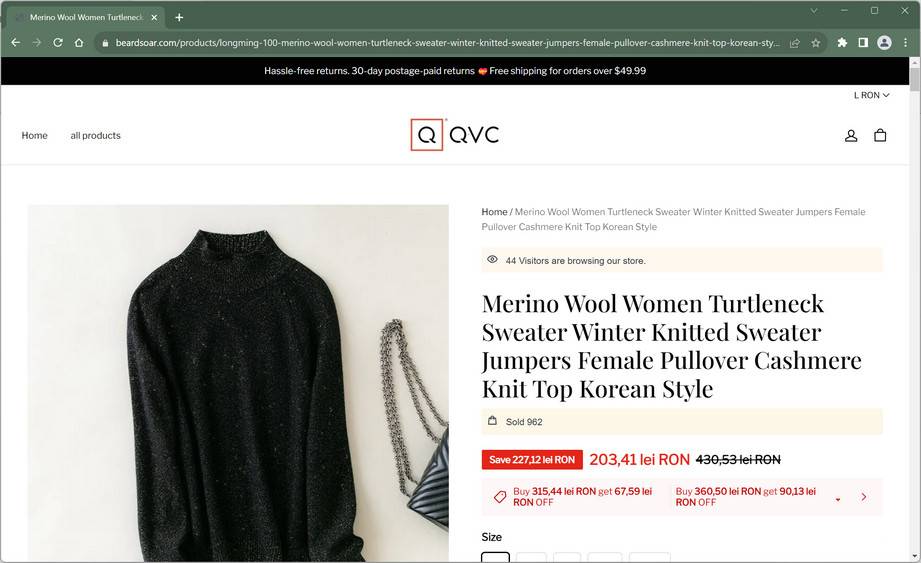QVC is an American cable, satellite and broadcast television network popular for shop-from-home TV offerings. But an elaborate scam website is falsely promoting a fake “QVC Clearance Sale” with huge discounts to defraud customers.
This convincing scam has already duped many online shoppers, so it’s crucial to learn how it works and avoid being tricked. Read on for everything you need to know about spotting and steering clear of QVC Clearance Sale scams.




Overview of the QVC Clearance Sale Scam
The QVC Clearance Sale scam utilizes a network of sophisticated fake websites designed to mimic the look and feel of the real QVC shopping portal. Scammers aim to trade on consumer familiarity with the QVC name to lend credibility to their frauds.
These sham sites advertise QVC products like electronics, jewelry, home goods and more at steeply discounted clearance sale prices – often 60% to 90% off retail. But there’s a catch – the deals are intended to lure in victims rather than offer legitimate savings.
If shoppers place orders through these fakes sites, one of several negative outcomes typically occurs:
- No items are ever shipped after payments clear
- Cheap knockoffs are sent made of inferior materials
- Used, damaged or tampered goods arrive instead of new products
- Completely incorrect items show up unrelated to the order
On top of not delivering as promised, these scam websites also harvest users’ personal and payment details during checkout to benefit credit card fraud rings and shady reseller networks.
The QVC Clearance Sale scam is the handiwork of an organized cybercriminal group based primarily out of China. By managing a network of fraudulent sites, this group attempts to trick thousands globally into believing they’re ordering from an authorized QVC sale.
How the QVC Clearance Sale Scam Works
The organized crime syndicate behind this scam has optimized how to mimic legitimate websites and lure in victims:
Step 1: Create Convincing Fake Site
First, the scammers setup hosting infrastructure and register deceptive domain names which incorporate QVC’s branding but lead to servers the company doesn’t control.
QVC’s logos, product imagery, web copy, testimonials and HTML templates are lifted directly from legitimate company assets to create counterfeit sites appearing genuine on the surface.
To provide a final sheen of legitimacy, items on the fake QVC site are listed at 60-90% off MSRP alongside pitches like “Going out of business sale” and “Clearance prices won’t last!”.
Step 2: Promote Fake Site Extensively
Once built, the scam website is promoted across a spectrum digital channels ranging from fraudulent ads on Facebook and Instagram to sponsored posts promoted on blogs – all aimed at funneling victims to the discounts.
Video ads in particular play a pivotal role, using urgent messaging around flash sales ending soon or limited item quantities available to prompt quick purchases before visitors scrutinize the site too closely.
Step 3: Harvest User and Payment Data
Victims land on slick, functional store templates lined with photos of QVC products. Without comparing URLs, most assume the site is legitimate based on branding alone and begin shopping.
At online checkout, personal info like names, addresses and phone numbers are collected along with financial data including credit card numbers, security codes and expiration dates – everything fraudsters need to resell or directly misuse identities.
Step 4: Process Payments and Disappear
After payments clear, orders unsurprisingly go unfulfilled by the criminals. Fake shipping notifications are sent to victims to delay suspicion and buy time for money transfers to clear before alarms are raised over unreceived goods.
By planning each phase meticulously in advance down to the final steps, scam networks successfully operate these schemes at scale for months on end with relative impunity.
Red Flags of the QVC Clearance Sale Scam
While easy to be fooled by slick websites and tempting deals, scrutinizing for these telltale signals can help avoid falling victim:
- Extreme discounts of 60%+ on all items should raise suspicions of any retailer
- No physical address or working customer service phone number provided
- Identical privacy policies, terms of use and about us pages to other sites
- Subtle differences in domain names and URL spellings from legitimate QVC portal
- No seller background like registered business details and history
- Payment policy demands bank wires, gift cards or cryptocurrency
- Poor grammar, spelling mistakes and other sloppy errors
- Complete lack of reviews, certifications, press mentions or community chatter
Wise consumers should steer clear of businesses exhibiting multiple red flags – especially secondary marketplaces offering prices too good to true paired with opacity around operations. If you feel misled or confused by any retailer, move on rather than risk your data or money.
How to Spot This Scam on Social Media
A pivotal part of this scam relies on promoting fake discounts through social media ads and posts. Here’s what to look for on various platforms:
- Watch for video ads in feeds using real QVC product footage while overlaying text about clearance sales ending soon.
- Be suspicious of sponsored posts urging readers to “shop clearance” or “take advantage of blowout deals” before exaggerated deadlines.
- Click “Why am I seeing this” on questionable ads. The transparency section will hide advertiser details for scams while showing real brand info for legitimate ads.
- Fake Facebook pages also impersonate QVC’s official handles and run ads. Compare page creation dates and URLs to spot knockoff accounts.
- Scam Instagram accounts imitation QVC also run video ads linked to their fake clearance sale websites, viewable by tapping the profile.
- Such ads tend to use consumer FOMO by claiming “today only!” massive price drops on rarely discounted top-selling products.
- Besides ads, scam accounts also make regular posts announcing “flash sales” while using QVC’s logos and stolen product photos to appear legitimate.
- No contact info, company history or physical HQ address can be found the Instagram profile or linked website, unlike on QVC’s real pages.
TikTok
- Video ads demonstrate QVC products alongside custom graphics boasting huge markdowns for clearance events said to end in hours.
- Music trends, popular audios, funny captions and more are tactically used for engagement bait, hoping to divert attention from deceptive links.
- Just like on Facebook and Instagram, no transparency about advertisers can be found which exposes the videos as scams avoiding scrutiny.
- Fake TikTok accounts also typically block comments and deletes responses calling them out for impersonation or fraud.
Careful consumers should leverage social platforms’ transparency features while verifying seller details present on linked sites. Scrutinizing rather than impulse buying is key to avoiding modern online scams.
Safely Shopping at Real QVC Websites
While scams impersonating QVC run rampant, the real QVC shopping experience features stringent protections against fraud:
- Real QVC sites confirmed by URLs starting with “qvc.com”
- Working 1-800 customer service numbers listed to assist with any order issues
- SSL encryption visible via padlock icon next to URLs along with “https”
- Company history, leadership profiles and real office locations provided
- Competitive prices compared to other retailers rather than extreme discounts
- Solid trust and review scores from independent consumer sites
Savvy shoppers should verify these markers of security and trustworthiness are present before shopping at QVC or any lesser known online merchant. Exercising caution is the best way to secure data and avoid online retail scams.
What to Do if You Were Scammed
If you made purchases through a fake QVC clearance sale website that never delivered or sent fraudulent products, here are important steps to take:
1. Contact Your Bank and Payment Providers
Notify your credit card company, bank, or any other payment provider that processed transactions for the scam purchases. Request that they reverse the charges due to fraud. Provide details on how the retailer misrepresented themselves in the process.
2. Monitor Accounts Closely
Keep close watch on your financial accounts and payment methods used on the scam website for any suspicious transactions. Fraudsters who obtain your personal information may attempt future charges or account takeovers. Report any unauthorized activity immediately. Enable account alerts where possible.
3. Lock Down Affected Accounts
Change passwords on all online accounts that utilized the same or similar credentials to those entered on the scam website as a security best practice. Turn on two-factor authentication (2FA) to add an extra layer of account protection on logins.
4. Report Details to Authorities
File a complaint with the FBI’s Internet Crime Complaint Center (IC3) and Federal Trade Commission. Provide both agencies with website details, transaction records, screenshots and any other relevant documentation. This can support investigations into larger scam networks.
5. Leave Online Reviews
Post reviews regarding the scam website anywhere online that potential victims may encounter them – especially product listings falsely showing discounted items for sale. Explicit warnings can help prevent others from being victimized.
6. Seek Legal Counsel
For high-value scam cases, consulting an attorney experienced with consumer fraud claims is advised. They can review if civil or criminal legal action against scammers is feasible based on evidence and losses incurred. Laws vary by state.
Taking swift action lessens damages from online retail scams using deception and theft. Preventing further victimization also remains key until criminally-operated websites can be penalized and shut down. Remain vigilant but don’t blame yourself if misled by intricately designed scams.
Frequently Asked Questions About the QVC Clearance Sale Scam
The QVC clearance scam leaves many confused consumers with critical questions. Here are comprehensive answers to some often-asked FAQs regarding this fraud.
Is there really such as thing as a QVC clearance or liquidation sale?
No. Unlike traditional retailers, QVC does not offer seasonal clearance sales or liquidate overstock merchandise at blowout pricing. As primarily a television and online shopping network, QVC controls its inventory closely rather than rely on brick-and-mortar locations demanding frequent sales. Any website advertising major QVC price cuts year-round should be scrutinized closely for fraud.
How do I tell the difference between real QVC sites and scam fakes?
Authentic QVC websites use official company domain names like QVC.com and QVC.com/[country code] based on regions. Fakes use misspelled or slightly altered domains. Real QVC sites also list a working customer service phone number on each page along with complete contact details. Scams lack this while using copied templates and content associated with other frauds after inspection.
Can I get scammed shopping directly on QVC.com?
Shopping directly via real QVC digital properties like QVC.com, the QVC app, and QVC’s verified social media pages ensures you engage with legitimate company channels rather than scammers impersonating them. As with any major retailer, only entering payment details at secure online checkout areas protected by SSL encryption keeps your info safe.
How do scammers use social media to promote QVC clearance sale fakes?
Scammers leverage platforms like Facebook, Instagram and TikTok to run ads promoting their sham QVC sales. Fake accounts impersonating QVC may also directly engage followers with posts and messages urging them to purchase heavily discounted items from provided links. These all redirect to fraudulent sites unaffiliated with the real company. Videos using QVC product footage while claiming “final hours!” or “limited quantities!” aim to pressure victims into ignoring red flags around seller legitimacy.
What should I do if already scammed by a fake QVC clearance sale?
First, contact your bank or payment provider immediately to halt charges and have fraudulent payments reversed to limit losses. Next, monitor accounts closely and reset passwords on a preventative basis in case the site stole login credentials or enough personal data to attempt identity theft. Report details to the FTC and IC3 while warning contacts also potentially exposed. For high losses, consulting an attorney knowledgeable with consumer scams can explore any civil or criminal legal remedies available in your state.
Conclusion
The QVC Clearance Sale scam demonstrates sophisticated fraud tactics leveraging social engineering techniques combined with convincing website designs. By studying their playbook in depth however, shoppers can empower themselves to spot fraudulent discounts and deceptive retailers.
Learning to identify subtle red flags indicating shady business practices allows consumers to avoid online pitfalls and enjoy worry-free shopping experiences. Stay informed and remain vigilant to protect your hard-earned money.










